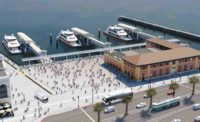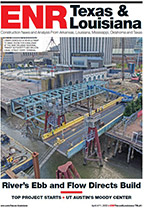Ferry Boost New South San Francisco ferry terminal project off and running
The project team’s task at the South San Francisco Ferry Terminal project at Oyster Point Marina seemed reasonable enough:

Design and engineer a ferry terminal off the unpredictable waters of San Francisco Bay and make sure it can withstand a catastrophic earthquake while still meeting the letter of the Americans with Disabilities Act. Oh, and make sure the ferry itself is made of concrete -- and floats.
Not a problem, says Bo Jensen, vice president of Oakland-based Moffat & Nichol Engineers, one of the marine engineering firms hired by owner San Francisco Bay Area Water Emergency Transportation Authority for the terminal project.
“A concrete float is unusual for this part of the country, but there are other concrete floats out there,” Jensen says. “There are even concrete ships out there. It’s just a matter of displacing the right amount of water.”
The $26-million terminal project will provide ferry service to an anticipated 900 passengers a day to and from San Francisco and Alameda. The first phase of the project, completed in December, involved removing two Oyster Marina docks, shortening three others, and dredging the entrance channel and terminal basin to 10 ft.
The next phase will include construction of a 4,000-sq-ft terminal and a 92-ft-long, 12-ft-wide floating gangway and installing the 130-ft-long by 40-ft-wide float.
WETA was expected to select a general contractor for the design-build project at press time. Firms under consideration for the contract include Manson/Dutra Joint Venture of Seattle, Power Engineering Contractors of Alameda, and General Construction Co. of Polusbo, Wash. Already onboard are Moffat & Nichol, project architect ROMA Design Group of San Francisco and marine engineer Simpson Gumpertz & Heger of San Francisco. “This will be the first new ferry terminal in San Francisco Bay in a long time,” says John Sindzinski, manager of planning at WETA. “It’s part of an overall program to increase water-transit service to help improve traffic and provide alternatives to driving. It’s also intended to be an important asset in the event of a natural or manmade disaster.”
WETA’s “overall program” is to triple ferry ridership in the bay from its present 4 million passengers annually to 12 million.
Also driving the South San Francisco terminal project is the presence in the city of the biotech giant...


